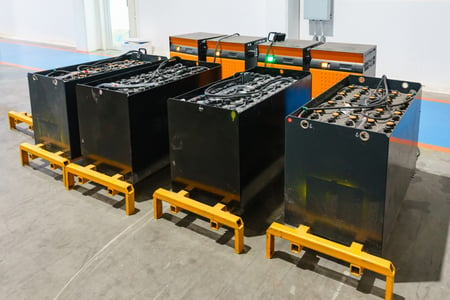 Ever since electrified forklifts came into being, almost 100% of them have used flooded lead acid batteries. In the last 10 years, many other battery options have been introduced to unseat the Goliath. Only now are they getting any real traction, but it’s just a start, since the other options are still less than 20% of the market. This is the first moment lithium, hydrogen fuel cells and TPPL (thin plate pure lead) have begun meeting our Application Engineering team's requirements to use them in GuaranteedPOWER® systems for select applications.
Ever since electrified forklifts came into being, almost 100% of them have used flooded lead acid batteries. In the last 10 years, many other battery options have been introduced to unseat the Goliath. Only now are they getting any real traction, but it’s just a start, since the other options are still less than 20% of the market. This is the first moment lithium, hydrogen fuel cells and TPPL (thin plate pure lead) have begun meeting our Application Engineering team's requirements to use them in GuaranteedPOWER® systems for select applications.
Why has it been so hard to unseat flooded lead acid batteries? Perhaps it would help to start by comparing a car to a forklift in miles driven in a year...
A forklift on the low-end runs 1000 hours a year. In our high-use facilities (aka high-velocity facilities), it can run 2500 hours or more. For comparison, the average American with a significant commute drives 15,000 miles in a year. Let’s say their average miles per hour is 50. Dividing 15,000 by 50 get you 300 hours of total use in a year.
Since the average forklift in a distribution facility operates 1500 hours a year, that means a typical car is in use only 20% of the time that a forklift is. In other words, it would take a car five years to reach one year of forklift use. If the forklift was used 3000 hours a year – and some are -- you’re talking about the equivalent of 10 “car years.” That’s a big difference!

In addition, a forklift runs on a battery whereas most cars today run on gasoline. This is important because batteries operate differently than gas — for example, they need charging and they don’t do well with heat. When the forklift runs during a hard shift, it’s not given time to rest or cool down. Usage and charging increase/create heat, and without any rest time, this can be a major challenge to a battery. Overall, today’s forklifts are pretty amazing machines when you consider how hard they run in one year; perhaps the battery powering them is pretty incredible as well?
That said, when you think about the hours a forklift will run in a year and the likelihood that something can go wrong on a sizing, software, usage or safety level, you realize just how much needs to be considered. This is why we are so passionate about operational and power assessments. We use them to design systems that are the right “fit” from the get-go, but also have the flexibility to adapt to rapidly changing, dynamic supply chain and material flow needs. The reality is, while the lead acid battery is "old faithful," we are having strong success with newer technologies in many high velocity applications.
Electrifying forklifts and implementing new technologies is not for the faint of heart. This is not like picking up an AA battery and putting it in your kid’s remote-control car. This is about electrifying a forklift that runs five times as much as a car does in any given year.
The power train of your forklifts are critical to your operations' material flow, productivity and uptime -- not to mention cost structure! If you are rethinking your forklift equipment or power system, make sure you work with a partner that considers every technology option at your disposal and is not fixated on a certain one. And make sure you get detailed, thorough power and operational assessments that consider all the angles. Hope this is helpful -- would love any questions, comments, or challenges to this!


 Ryan Lynch
Ryan Lynch

